|
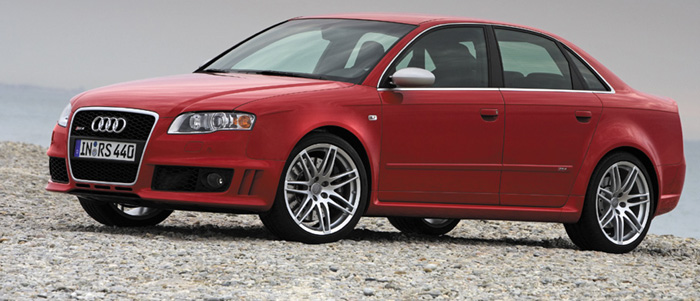
The Audi RS 4 – the sports car for 365 days a year
The new Audi RS 4 from quattro GmbH breaks new ground in every respect, impressively demonstrating the
leading-edge engineering embodied in the "Vorsprung durch Technik" slogan. The saloon features numerous innovations, delivering top performance whether on the road or on the track. This latest model developed by
Audi subsidiary quattro GmbH combines motorsport technology with a high standard of practical value for everyday use. In creating this car, Audi's development engineers have succeeded in placing a sporty
all-round concept on the road which is capable of thrilling its driver in every situation, whether in everyday motoring or on the race track.
The Audi RS 4 continues the tradition of quattro GmbH in bridging the gap between motorsport and everyday motoring. It is a car which combines emotion and functional perfection, meeting all the demands made by the
driver of a high-performance car in general and an Audi in particular in today's motoring world.
At Audi, the "RS" abbreviation stands for unmatched performance, technological innovation and unique
driving dynamics. To quote just two examples, the 420 bhp eight-cylinder engine is Audi's first high-revving power unit, and also features its innovative FSI technology. A further forte of this exceptional V8 is its
extremely compact size. The RS 4 for the first time features the latest generation of the permanent four-wheel drive system with asymmetric/dynamic torque distribution, under normal driving circumstances
transferring 40 percent of the power to the front wheels and 60 percent to the rear. It is particularly well suited to a sport car of the calibre of the RS 4.
With each and every component of the new car being checked for minimum weight, the result of the consistent weight reduction process is a power-to-weight ratio of 3.93 kg per bhp.
The RS 4 is a truly unique, intelligent vehicle concept with superior drive train qualities, offering driving dynamics unmatched by any other car in its segment.
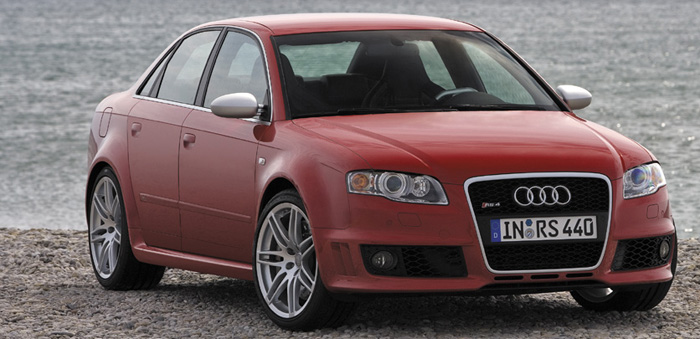
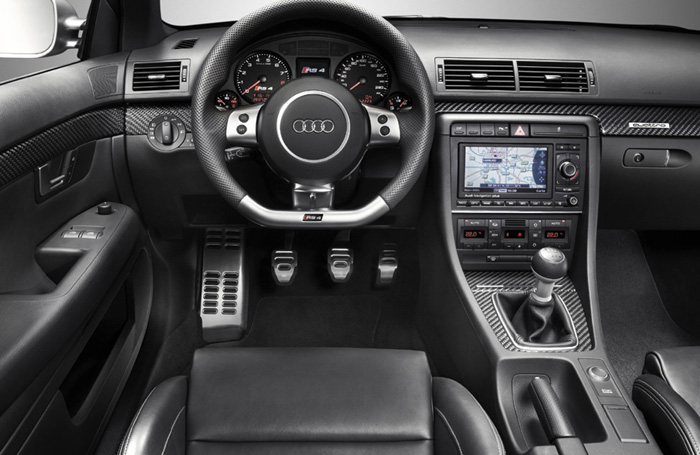
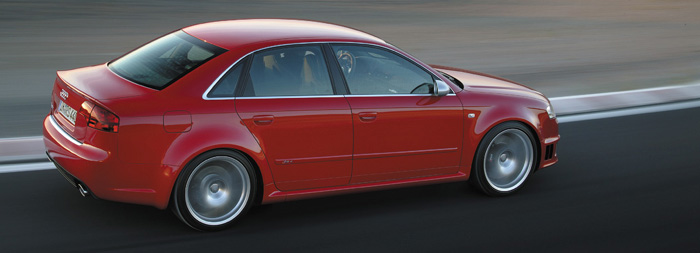
Interior
The premium sports car
Premium quality typical of Audi and the levels of genuine sportiness typical of an RS model are combined in
harmony in the interior of the RS 4. As soon as you sit in it, you know that you are in a true sports car.
The bucket seats, with their high side sections, provide excellent lateral support. The side sections can be
inflated individually by means of two buttons on the seat or by pressing the Sport button on the steering wheel, and thus fit themselves perfectly to the driver's anatomy. Pressing the Sport button also modifies the
characteristic line of the accelerator, producing a more graduated engine response. Moreover, the exhaust sound has been modified to make it even sportier. The
RS bucket seats are available either in full leather throughout or in a combination of leather and cloth. Sports seats are available as an option.
Attention to detail is demonstrated in the choice of materials and the workmanship applied in processing them. Leather, aluminium and carbon are the predominant materials in the interior. The flat-bottomed RS
steering wheel, developed exclusively for the Audi RS 4, is covered in perforated leather. Carbon-fibre trim inside the car serves to additionally accentuate the sporting qualities of the RS 4. A range of further trim
options are also available: Piano finish black, Fine grain myrtle nutmeg and Aluminium matt. A further detail is the design of the milled aluminium door openers, echoed also on the gear knob and the steering wheel. The
gear knob, handbrake lever and steering wheel are also covered in perforated leather.
The driver information system incorporated into the typical RS-design cockpit additionally features an oil
temperature gauge as well as a stopwatch with lap timer function – a useful extra for those special track days so beloved of RS 4 drivers.
The driver information system welcomes the driver upon entering the car with the exclusive RS welcome logo. The eight-cylinder engine is started by pressing the Start button in the centre console.
The aluminium pedals are a further echo of the motorsport world, and also help to save weight.
Engine
FSI delivers even better power and performance
The engine is key to the quality of any sports car. In the new RS 4, quattro GmbH has placed its trust in a
compact V8 unit featuring petrol direct injection. In the 420 bhp high-revving eight-cylinder engine, FSI technology has reached a new highpoint. In this top product of what is a still young yet already highly
successful technology, the petrol is injected directly into the combustion chamber, resulting in a uniform fuel/air mixture. Thanks to the cooling effect of the directly injected fuel, Audi's development engineers have
at the same time been able to increase the engine's compression ratio.
The result is an even more efficient combustion process and, consequently, an even higher power output.
This is demonstrated most clearly in the engine's more spontaneous responsiveness. Thanks to this technically highly sophisticated injection method, optimum power output is produced in every driving situation.
FSI technology is already deployed in the world's most successful racing car, the Audi R8, winner of the legendary Le Mans 24 Hours race no less than four times in the last five years alone (to mention just some of
the car's outstanding achievements). The figures illustrate the outstanding potential of the eight-cylinder unit. At 7,800 rpm the 4.2 litre engine delivers 420 bhp of power output. Peak torque is 430 Newtonmetres at
5,500 rpm. And no less than 90 per cent of this maximum torque is maintained consistently throughout a wide range of engine speed from 2,250 all the way to 7,600 rpm. Performance on the road is naturally equally
impressive: the RS 4 accelerates to 100 km/h in 4.8 seconds and reaches 200 km/h in 16.6 seconds. At 250 km/h the vehicle's speed is smoothly limited by an electronic control system.
The principle of the high-revving engine
Audi has deployed the high-revving engine principle for the first time in the RS 4. The maximum engine speed
is 8,250 rpm. The significant advantages of this principle are superior power output at high engine speeds and a smooth, eager responsiveness all across the revs range. Further fortes are the car's outstanding
agility and fast-revving response as well as the kind of racing-style engine sound drivers of such cars expect. As a result of these qualities, the eight-cylinder power unit provides maximum thrust and
performance in virtually all driving situations.
The ultra-compact V8
The V8 power unit is ultra-compact in its dimensions, fitting snugly into the engine compartment of the RS 4
without requiring any modifications to the body. The camshaft and ancillaries, with the exception of the alternator, are all driven by a chain for easy maintenance. An all-new development, features of the
eight-cylinder unit powering the RS 4 include modified pistons and conrods, a new crankshaft together with its bearings, and new cylinder heads. A twin exhaust system with enlarged pipes provides even higher power
output. These extensive measures enabled the 4,163 cc engine to break through the magical 100 bhp per litre barrier.
The car's power-to-weight ratio is also impressive: 3.93 kg per bhp is a figure only the most thoroughbred sports cars were able to offer just a few years ago.
It goes without saying that the V8 featuring FSI technology complies with the Euro 4 emissions standard.
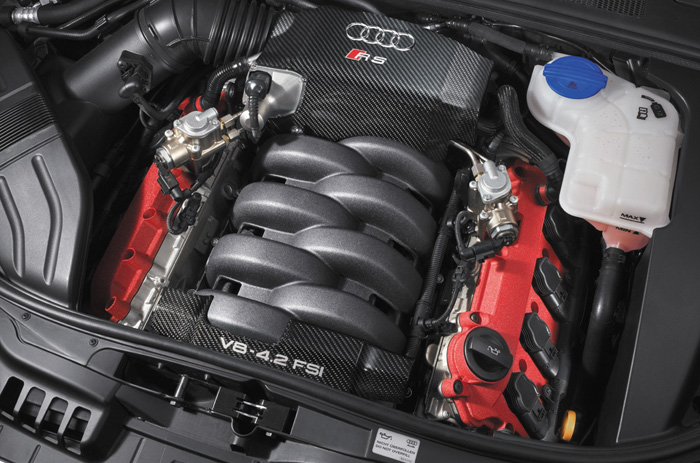
Drivetrain
New generation of quattro drive
Getting all this power on to the road was of course a significant challenge. Audi's answer is – of course – its
quattro permanent four-wheel drive system. A quarter of a century's experience and market leadership in the four-wheel drive car segment represent genuine benefits for Audi's customers. The RS 4 features a new
generation of quattro drive with asymmetric/dynamic torque distribution.
A Torsen centre differential distributes the power to the front and rear wheels as required, thereby ensuring
optimum traction. In variable road conditions the power can be immediately diverted in full to the front or rear depending on the torque. The new distribution system, which under normal road conditions transmits 40
percent of the power to the front wheels and 60 percent to the rear, makes the Audi RS 4 an even more impressively dynamic drive. Alongside traction, controllability, stability, load reversal and transitioning,
aspects of agility and steering have also been substantially enhanced, underscoring the highly sporty character of the car.
The term "Torsen" comes from "torque" and "sense" which, taken together, quite literally means "sensing the development and build-up of torque". The Torsen differential is a self-locking worm gear. Thus the locking
action is only prompted under the influence of the drive train. On braking and cornering the gearbox does permit differences in engine speed, however.
The rear axle differential is fitted with additional cooling fins. This is Audi's response to the high loads to which the RS 4 may be subjected.
Ensuring very short gearshift travel, the six-speed gearbox combines compact dimensions with low weight and a high standard of shift comfort. Adapted to the power unit of the RS 4, the gearing provides excellent
power yield in practice, conveying the output of the engine to the driven wheels of the car with maximum efficiency.
Suspension
In full control at all times
Even the best drive train is nothing without the right chassis and suspension. In the Audi RS 4, quattro GmbH has consistently applied all the benefits of the quattro drive system and the engine. The standard sports
suspension ensures that the engine's output is transferred just as needed to the road.
This superiority is ensured on Audi's new sports saloon by a high-performance aluminium suspension with a
four-link front axle and a trapezium-link rear axle. Precise steering, with sensitive feedback, sporty agility and excellent directional stability make the RS 4 the perfect car both for the motorway or country road and for
the race track.
Each wheel on the front axle is guided by four aluminium transverse links. The trapezium-link rear axle offers
top-class driving dynamics. This torsion-proof and non-flexing trapezium link absorbs a large portion of the forces acting on the wheel. Together with the track link further to the rear, this special configuration defines
the elastokinematic behaviour of the rear axle with ultimate precision.
Dynamic Ride Control
The Audi RS 4 comes with Audi's DRC Dynamic Ride Control, as featured for the first time in the Audi RS 6.
DRC serves to reduce both body roll and pitch along the car's longitudinal and lateral axes.
This is accomplished by interconnecting the dampers diagonally by way of a central valve. Body movements
when driving off are largely eliminated in this way, as are pitching movements when braking, or rolling when cornering fast. This has further enhanced the driving dynamics offered by the RS 4.
DRC has already been supremely well received in the RS 6. In the RS 4 quattro GmbH has succeeded in making the system more compact and lighter. Dynamic Ride Control employs no electronics whatsoever.
The combination of quattro drive, DRC, and the suspension specifically geared to the RS 4 allows this outstanding high-performance Audi to hold the road safely even in the absolute limit ranges at top cornering
speeds, when other drive concepts have long since reached their limits. It goes without saying that the
Audi RS 4 features the latest generation of ESP stability control designed and configured especially for this
car. Its interventions are now later and shorter. It is also possible to delay intervention further, or to disable the ESP altogether.
18-inch wheels as standard
The RS 4 is fitted as standard with 18-inch wheels and 255/40 R18 size tyres.
19-inch wheels are optionally available. For the RS 4 the Audi designers produced a range of light and
attractive cast aluminium wheels of five-spoke design. A special manufacturing method means the wheels are stronger, thinner and lighter. The tyres are size 255/35 19. The 19-inch wheels can also be optionally fitted
with Pirelli P Zero Corsa sports tyres, which are specially designed for the RS 4 for race track use.
Compared with the standard A4, the RS 4 is lowered by 30 millimetres. A further important change is the
wider track, increased by 37 millimetres at the front and 47 millimetres at the rear. The spring and damper tuning has of course also been adapted to the sporty dynamics of the RS 4.
The servotronic steering has been specially tuned to the requirements of the sports saloon. With its direct response and short travel, it is outstandingly well suited to the overall character of the RS 4.
Brakes for the race track
The RS 4's braking is also impressive, based on an 18-inch brake system. The perforated and ventilated brake
discs measure 365 millimetres in diameter at the front and 324 millimetres at the rear. They are designed in a floating arrangement, meaning that the cast-iron friction ring of the brake system is bolted on to the
aluminium brake disc cover. The result is a significant improvement of the brakes' resistance to fading, particularly under extreme loads. A further side-effect of this technology is a reduction in unsprung masses.
A further advantage is the optimisation of brake air flow by means of NACA jets keeping the brake discs appropriately cool at all times.
Featuring eight-piston fixed callipers originally developed for motorsport on the front wheels (four pistons and two brake pads on the inside and outside of each brake disc) as well as single-piston swing callipers on
the rear wheels, the Audi RS 4 offers supreme stopping power and directional stability. The ESP 8.0 stability program, electronic brake force distribution, and the ABS anti-lock brakes have all been tailored to the
specific dimensions of the brake system.
An additional boost to safety is provided by the ESP stability program, with its dry braking function. When
the road is wet the system lightly applies the brake pads to the discs at regular intervals, unnoticed by the driver, to sweep water from them and so improve braking response. Further features included in the ESP
stability program are the electronic differential lock (EDL), traction control (ASR), electronic brake force distribution (EBFD) and anti-lock brakes (ABS).
It is also possible to disable the ESP in two stages: in the first stage only the traction control (ASR) function is disabled; in the second stage the ESP is completely deactivated, including the traction control. As a
result, there is no control intervention in any driving situation.
Design
Self-assured and highly functional
The design of the Audi RS 4 combines functionality with aesthetics. The car's appearance embodies the ultimate in uncompromising sportiness. In particular, the RS 4 demonstrates its enormous performance
potential where such qualities really count, boasting features such as:
·Flared wheel arches
·Bumpers in RS design with the trim grille in diamond look
·Flared side sills as well as door cut-out trim strips matched to the sills
·A rear spoiler integrated in the boot lid and side panels
·A twin-chamber exhaust system with oval tailpipes
·Aerodynamically optimised twin-arm design RS exterior mirrors in aluminium look
·Newly designed 18-inch five-spoke alloy wheels (and optional 19-inch wheels of seven-double-spoke design)
·RS 4 badging at front and rear and on the side rubbing strips
·Trim strips in matt aluminium
The sporty look of this exceptional saloon is combined with an equally high level of functionality. The large
inlets on the front end of the RS 4 guarantee optimum cooling of the V8 FSI engine. Flared wheel arches offer plenty of space for the 18-inch or 19-inch wheels. With enlarged tailpipe cross-sections, the
twin-chamber exhaust system provides for significantly reduced exhaust gas counterpressure. The 30 millimetre lowering not only provides a sporty look, but is also a major factor in delivering the outstanding
levels of driving dynamics the car offers.
Despite this uncompromising sportiness, the car's close family relationship with the Audi A4 is unmistakeable.
The distinctive single-frame grille and the sweeping headlights, borrowed from the Nuvolari prototype, underscore the family heritage of the RS 4.
Audi offers the RS 4 in nine exterior colours. The range extends from the subtle Avus Silver to the luminous Imola Yellow. And through Audi's customisation programme, quattro GmbH offers even the most discerning
customer a virtually unlimited range of individual colours and combinations.
Safety
Superior traction in every situation
The safety package Audi has put together for the RS 4 is both comprehensive and highly sophisticated. Particular attention was paid in the development of this high-performance saloon to the overriding need for
active driving safety. The quattro permanent four-wheel drive system already offers more traction than conventional drive systems in critical driving situations. Its variable distribution of power across the two axles
now also provides even greater benefit.
An additional boost to safety is provided by the ESP, with its integrated dry braking function. When the road
is wet the system lightly applies the brake pads to the discs at regular intervals, unnoticed by the driver, to sweep water from them and so improve braking response.
The ESP can be disabled in two stages: in stage 1 only the traction control (ASR) is disabled; the full ESP functionality is retained. In stage 2 the ESP is completely deactivated, including the traction control. The
electronic control ceases.
The RS 4 features a tyre pressure monitoring system as standard. The sensors located in the wheels continually measure the tyre pressure at three-second
intervals. In the event of an acute loss of pressure, the driver information system gives the driver both a visual warning sign and an acoustic alarm.
Extra-large brakes ensure stopping power quite comparable to that of a thoroughbred sports car. The perforated, ventilated brake discs measure
365 millimetres in diameter at the front, and 324 millimetres at the rear.
Passive safety of the highest standard
Great attention was also paid to the issue of passive safety in the development of the RS 4. A rigid body,
consistent and coordinated deformation properties, state-of-the-art restraint systems – including the two-stage front airbags – and, last but not least, the sideguard head airbag system provide exemplary levels
of occupant protection. This head-level side airbag system covers virtually the entire side window area, from the A-post to the C/D-post. The airbags themselves are inflated by a hybrid gas generator, which maintains
the airbag pressure for several seconds to provide ongoing protection.
This means sideguard provides full protection even in a secondary collision such as when the car rolls over
following initial impact. And the new RS bucket seats, in conjunction with the belt system, offer additional safety and restraint in the event of a side-on collision so that the RS 4 does not even require side airbags in
order to meet the stringent crash test requirements.
Equipment
Light and comprehensive
Although weight was one of the main considerations in the development of the Audi RS 4, the car boasts an
extensive range of equipment. Standard features include a deluxe automatic air conditioning system, as well as the concert radio system. Central locking and electric windows are also featured as a matter of course in
a car of this class.
The acoustic parking system at the front and rear protects against irritating dents and scratches when parking. The high-intensity xenon plus headlights provide optimum visibility.
The RS logo is worked in to the flat-bottomed leather sports steering wheel as well as in the seat upholstery and door sills. Two of the functions controlled directly from the ergonomically designed RS sports steering
wheel are the lap timer and the Sport button. Dynamic Ride Control (DRC) provides sporty, dynamic handling by significantly reducing body roll and pitch.
The Audi RS 4 comes with 18-inch cast aluminium wheels of
five-spoke design. Optional extras are 19-inch wheels of seven-double-spoke design. Here, too, weight saving is combined with sporty design.
Audi offers an extensive range of optional extras for the RS 4. They include the navigation system plus, the symphony radio system, various exterior mirror versions (optionally also folding), as well as the sports
suspension plus. The comfort package comprises features such as cruise control as well as heated front seats.
RS Models
The new Audi RS 4 is the latest offspring of the RS family from quattro GmbH. The debut of the first RS 4 in 1999 – at the time the first high-performance model independently produced by the Audi subsidiary –
attracted lots of admiring looks. At the same time it redefined the concept of a high-performance vehicle.
In a truly impressive manner, the first RS 4 proved the great potential offered for the future by Audi's sporty
models.
And Audi's first RS model also impressed its fans right from the off. The
RS2 Avant amazed the motoring world with its performance. This five-cylinder turbo model entered the
market in 1994 and was built for a little over a year. Its engine delivered 262 kW (315 bhp). 2,881 customers opted for this sports car, which was based on the Audi 80 Avant. The RS2 has long since become a
sought-after classic with a loyal fan club.
The first-generation RS 4 demonstrated what still marks out every RS vehicle to this day: an uncompromising
combination of emotion and functionality. The very first Audi RS 4 Avant attracted customers by its outstanding combination of family practicability and everyday motoring qualities blended with driving
performance offered up to that time only by the most thoroughbred sports cars.
The success was impressive: although the RS 4 remained in production for just 14 months, more than 6,000
buyers opted for this sports car in its Avant body style during that time.
And the RS 6 that succeeded it rapidly attracted an enthusiastic fan club of its own. At the end of the
production run the limited-edition 480 bhp RS 6 plus was also put on sale. The RS 6 was the first RS model to be sold by Audi in both saloon and Avant guise.
This successful combination will be continued in the new RS 4. Altogether over 8,000 examples of the RS 6, including the RS 6 plus, were sold worldwide.
By creating the new Audi RS 4, quattro GmbH has proved once again that there is no need for compromise in developing a sports car fully suited to everyday motoring. Indeed, the RS models highlight the engineering
and technological expertise of Audi more than virtually any other car.
The new Audi RS 4 also comes with a wide range of innovative technical features, emphasising the strengths
of the brand through the use of FSI technology and the new-generation quattro permanent four-wheel drive. And at the same time Audi is taking a new approach with this outstanding model, for example by introducing
the high-revving concept already tested successfully in motor racing.
The RS models from quattro GmbH are emotionally exciting sports cars which have to date attracted a large
and enthusiastic fan base. That success will continue with the new RS 4.
Audi has always offered the RS driver perfectly engineered and highly emotional driving machines providing a
high level of everyday motoring practicality, and the concept has attracted an enthusiastic fan base. That will not change with the new
RS 4.
Responsible also for the "S line", "Audi exclusive", and "lifestyle articles" option packages and product lines within the Audi Group, quattro GmbH is making a significant contribution in further enhancing Audi's position
as an outstanding and emotionally exciting sports brand.
|